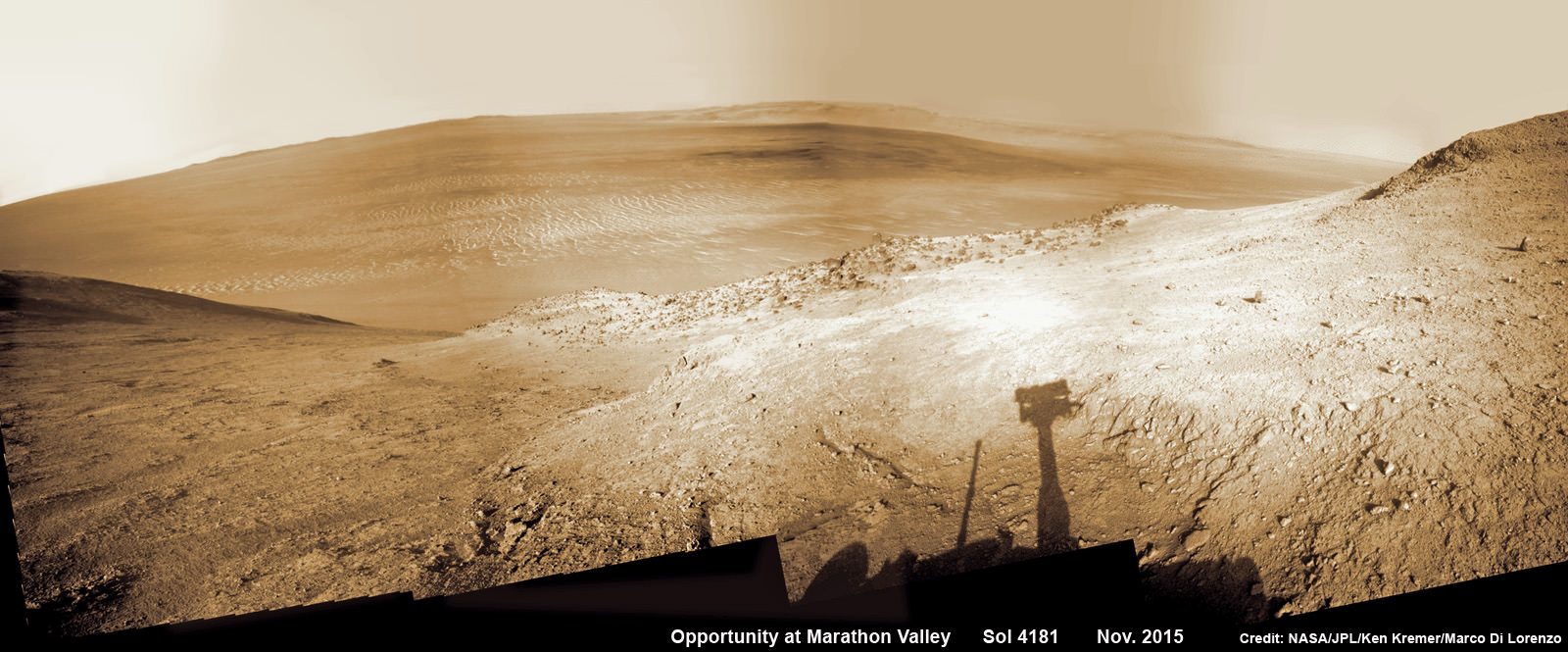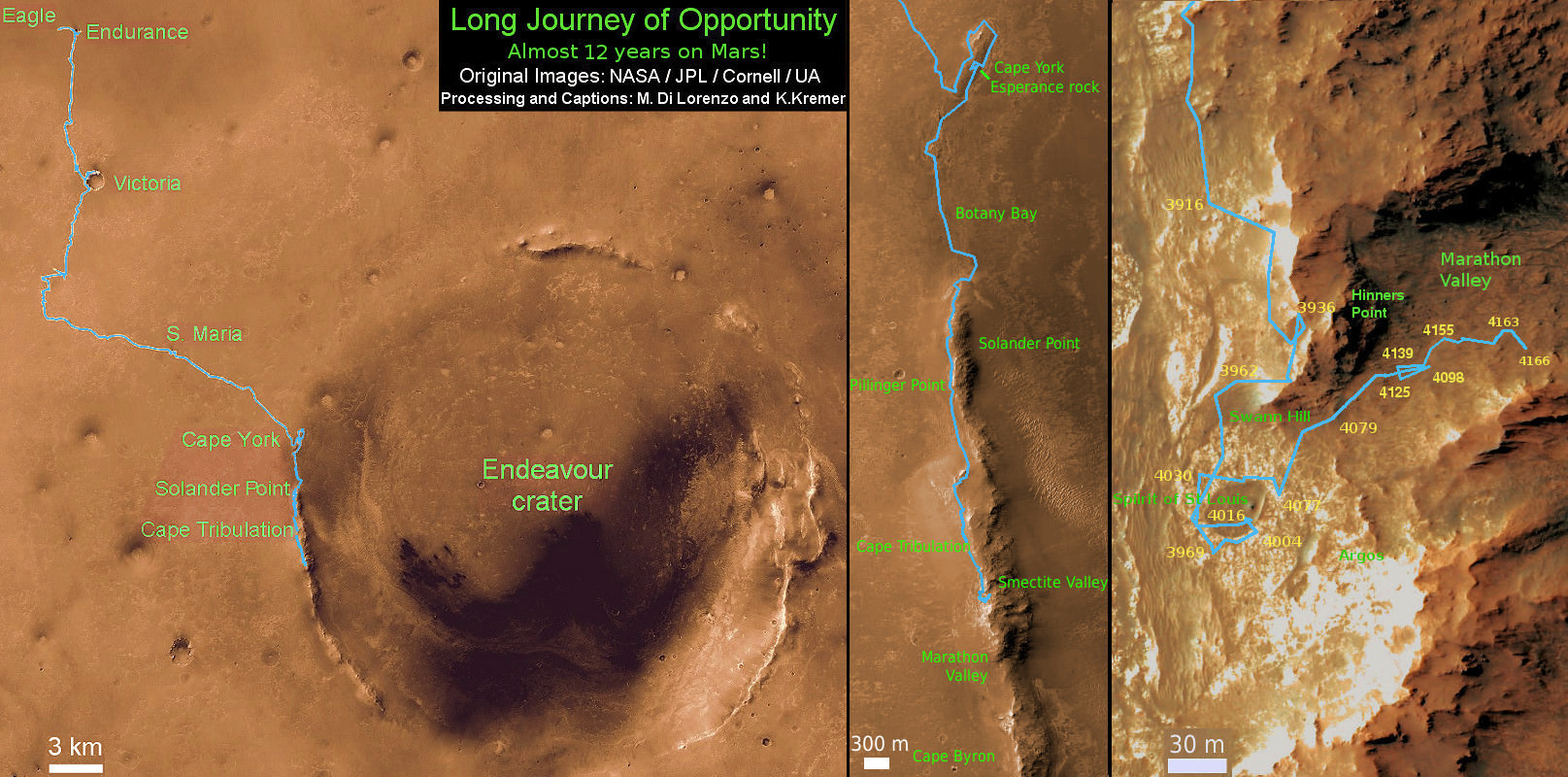
Just shy of an unfathomable 4200 Sols traversing ravishing alien terrain on the Red Planet, the longest living ‘Martian’ – NASA’s robot ‘Opportunity’ – is driving between “lily pads” down steep walled Marathon Valley in search of life giving sun that enables spectacular science yielding clues to Mars watery past. All this as she strives to survive utterly harsh climate extremes, because ‘winter is coming’ for her seventh time on the fourth rock from the sun!
“Opportunity is driving east and southeast down Marathon Valley, bisecting the region in which we detect smectites [clay minerals] using CRISM [spectrometer] data,” Opportunity Deputy Principal Investigator Ray Arvidson, of Washington University in St. Louis, told Universe Today.
The ancient, weathered slopes around Marathon Valley became a top priority science destination after they were found to hold a motherlode of ‘smectite’ clay minerals, based on data obtained from specially targeted and extensive Mars orbital measurements gathered by the CRISM (Compact Reconnaissance Imaging Spectrometer for Mars) spectrometer on NASA’s Mars Reconnaissance Orbiter (MRO) – accomplished earlier at the direction of Arvidson.
The water altered smectites form under wetter, milder conditions than most rocks at the Opportunity site and under environmental conditions more conducive to support Martian microbial life forms, if they ever existed past or present. Opportunity is investigating relationships among clay-bearing and neighboring deposits for clues about the history of flowing liquid water and environmental changes.
With winter now fast approaching, the ever resilient rover has shifted the focus of science investigations – 130 months into her planned 3 month expedition!
In mid-October she moved from the northern region to the southern side of Marathon Valley, where the life-giving solar arrays can soak up more of the sun’s rays from the sunniest spots along the north-facing tilted slopes and thereby generate more power to continue research activities at the tasty outcrops.
“Opportunity is about halfway down the [smectite] detection zone and biased toward north facing “lily pads” on the southern side of the valley for end of drive locations – for power reasons,” Arvidson explained.

During the next few months of Martian fall and winter, the engineering team will intentionally park Opportunity at end of drive locations where her solar panels are advantageously tilted towards the sun.
“Winter solstice is coming up in early January 2016,” Arvidson told me.
“Effectively we have entered the winter plan of staying along the southern margins of the valley to enjoy north facing slopes and associated increased sunlight. This is the plan for the next number of months, image the floor and gathering some limited MI and APXS data while on the ‘lily pads’.”
The shortest-daylight period of this seventh Martian winter for Opportunity will come on 11 January 2016.

Marathon Valley measures about 300 yards or meters long and cuts downhill through the west rim of Endeavour crater from west to east the same direction in which Opportunity is driving. Endeavour crater spans some 22 kilometers (14 miles) in diameter.
Along the ‘lily pad’ route, the six wheeled rover is collecting a wealth of science data where no rover has gone before – in the form of Pancam and navcam camera imaging and spectroscopy – to place the regions outcrops of rocks in geologic context.
“At end of drives Opportunity is acquiring Pancam color and stereo images to map the valley floor to better understand the stratigraphy, structure, and color patterns,” Arvidson said.
See our photo mosaics herein illustrating Opportunity’s view around and about Marathon Valley and Endeavour Crater, created by the image processing team of Ken Kremer and Marco Di Lorenzo.
Opportunity is also snapping mosaics with the microscopic imager (MI) and gathering analysis of elemental abundances of rocks and soils with the Alpha Particle X-ray spectrometer (APXS).

However, the rovers engineering handlers back on Earth have to exercise added caution regarding exactly where they send Opportunity on science forays since she is descending into a step walled narrow valley that can occasionally hamper daily communications with NASA’s orbiters flying overhead which relay data back and forth.
The high walls to the north and west of the valley ridgeline has already caused several communications blackouts for the “low-elevation Ultra-High-Frequency (UHF) relay passes to the west,” according to the JPL team controlling the rover.

Another issue that the team occasionally has to deal with is bouts of “amnesia” wherein Opportunity undergoes “unplanned computer resets when using the type of onboard memory that retains information when power is off: flash memory.”
To avoid “amnesia” engineers successfully implemented a strategy whereby they routinely avoided use of the rovers flash memory by working in RAM-only mode (no Flash for storage). This requires all data collected to be transmitted back to Earth on a daily basis, otherwise it would be lost.
“This is being done in RAM mode, where the data are lost if not transmitted down before the rover goes to sleep,” Arvidson elaborated.
Meanwhile engineers are still trouble shooting the flash memory issue.
“Might try to mount FLASH again sometime over the next several weeks.”
Indeed the team has tested various workarounds and has reinstituted use of flash memory mode. But resets are still occurring infrequently so more investigatory work remains.
Overall Opportunity remains healthy with sufficient power to continue operations. The solar arrays produced 344 watt-hours of energy as of Nov. 3, 2015.
As of today, Sol 4192, Nov. 9, 2015 Opportunity has taken over 206,560 images and traversed over 26.48 miles (42.62 kilometers).

Meanwhile Opportunity’s younger sister rover Curiosity traverses and drills into the basal layers at the base of Mount Sharp.
And NASA’s newest orbiter MAVEN just confirmed that the solar wind stripped away Mars ancient atmosphere in the absence of a global magnetic field causing the evaporative loss of lakes of surface flowing water.
Stay tuned here for Ken’s continuing Earth and planetary science and human spaceflight news.

This map shows the entire path the rover has driven during almost 12 years and more than a marathon runners distance on Mars for over 4191 Sols, or Martian days, since landing inside Eagle Crater on Jan 24, 2004 – to current location at the western rim of Endeavour Crater and descending into Marathon Valley. Rover surpassed Marathon distance on Sol 3968 and marked 11th Martian anniversary on Sol 3911. Opportunity discovered clay minerals at Esperance – indicative of a habitable zone – and is currently searching for more at Marathon Valley. Credit: NASA/JPL/Cornell/ASU/Marco Di Lorenzo/Ken Kremer/kenkremer.com


Ahhh… Oppy! Keep on keeping on! Still high up in the ‘top ten’ favorite mission list? But then again, I have to admit Oppy, I haven’t been entirely faithful to you. Whereas.. I used to check your site every single day, lately it’s all been about Curiosity. Sorry, don’t get me wrong! NO! I still check on you once a week or so, or if anything cool comes up, which happens all the time.
P.S. What are you doing for Thanksgiving? We’ll be serving hydrolyzed smectites!